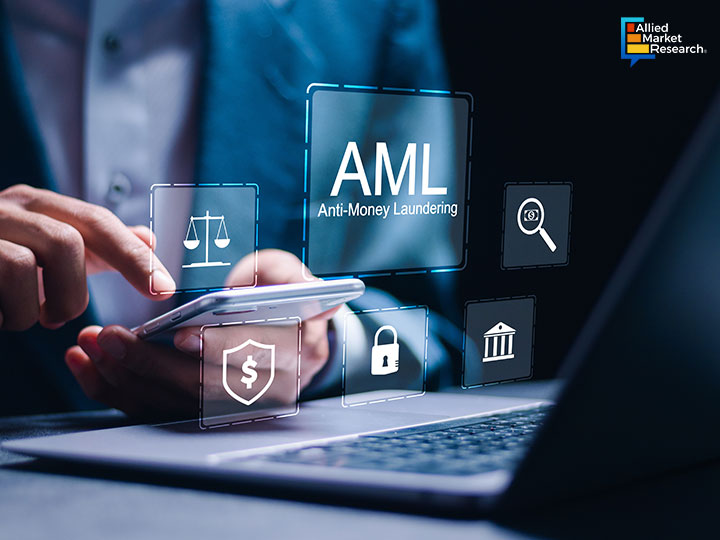Anti-money Laundering Software: An Essential Tool for Modern Financial Systems

3 Apr
2025
Anti-money laundering software is a cutting-edge technology that automates detection and inspection of suspicious transactions, thereby preventing money laundering. The software exhibits the potential to analyze massive volumes of transaction data, monitor customer behavior and patterns, and employ advanced analytical techniques to detect malicious activities. Money laundering is arising as a notable challenge, allowing terrorists and criminals to mask illicit funds as legitimate earnings. As a result, the need for anti-money laundering software is rising significantly across industries such as financial institutions, gambling and gaming, insurance companies, fintech, and real estate.
Understanding why Anti-money Laundering Software is Important
Anti-money laundering software plays a key role in protecting the integrity of financial systems by preventing revenue-generating activities like drug trafficking, human trafficking, corruption, and fraud. The 2024 Global Financial Crime report claims that financial crime costs reached more than $3.1 trillion in 2023. Governments are thus implementing stringent regulations to adhere to money laundering provisions, which are applicable to financial institutions, real estate transactions, high-value goods trading, online gambling platforms, and other sectors, which are vulnerable to illicit financial activities.
The regulatory bodies such as the Financial Crimes Enforcement Network, the Financial Action Task Force, and the European Banking Authority carry out stringent audits and investigations on a regular basis. However, if these regulated institutions fail to adhere to the guidelines, they are subject to hefty penalties. For instance, financial institutions that did not cater to the compliance requirements put forth by the regulatory bodies paid fine of approximately $6.6 billion in 2023. Thus, industries are heavily investing in anti-money laundering software to prevent penalties, reduce financial losses, and improve compliance. Allied Market Research stated that the anti-money laundering software market is estimated to account for $19 billion by 2033 from $4 billion in 2023, registering a CAGR of 16.7% from 2024 to 2033.
Assessing Different Types of Anti-money Laundering Software
Various types of anti-money laundering software include AML screening, KYC-KYB, risk assessment, and AML transaction monitoring. Suspicious entities and individuals are identified using the AML screening software whose records are registered on politically exposed person lists, sanction lists, and other watchlists. This software consists of a huge database of speculative institutions and people that pose high risk for money laundering or other malicious financial activities. The software further scrutinizes new customer or transaction data against the database and notifies the user if a match is detected. On the other hand, KYC-KYB comprises tools that aid organizations to gather and authenticate customer data like name, birthdate, address, and official identification documents, which are used to track and identify skeptical transactions or individuals.
Furthermore, risk assessment tools assist to mitigate financial frauds by performing enhanced due diligence and employing extra AML controls, thereby helping organizations to detect and prevent money laundering risks. Contrarily, in AML transaction monitoring, financial crimes are identified with the help of algorithms that evaluate transaction information and detect anomalies indicating money laundering. For example, AML transaction monitoring tool recognizes and flags a series of small payment transfers that are made in a short time span. These transfers may suggest an attempt of money laundering wherein an individual or entity splits a large amount into multiple smaller transactions to prevent detection by regulatory authorities. Thus, all these anti-money laundering tools are generally integrated in a single system that play a crucial role in assisting financial institutions to detect, prevent, and respond to money laundering risks effectively.
Final Note
With increasing risk of cybercrime and money laundering cases, the deployment of anti-money laundering software has boosted significantly. Financial Crimes Enforcement Network, the Financial Action Task Force, and the European Banking Authority are the major regulatory bodies that organize regular audits to mitigate financial frauds. The authorities also implement stringent regulations regarding transaction monitoring and reporting suspicious activities, which are applicable to organizations that are highly susceptible to financial frauds. As a result, anti-money laundering tools such as KYC-KYB, AML transaction monitoring, risk assessment, and AML screening are essential in preventing money laundering risks.

Koyel Ghosh
Author’s Bio- Koyel Ghosh is a blogger with a strong passion and enjoys writing in miscellaneous domains, as she believes it lets her explore a wide variety of niches. She has an innate interest in creativity and enjoys experimenting with different writing styles. A writer who never stops imagining, she has been serving the corporate industry for the last five years.
Avenue: Entire Library membership of Allied Market Research Reports at your disposal
- Avenue is an innovative subscription-based online report database.
- Avail an online access to the entire library of syndicated reports on more than 2,000 niche industries and company profiles on more than 12,000 firms across 11 domains.
- A cost-effective model tailored for entrepreneurs, investors, and students & researchers at universities.
- Request customizations, suggest new reports, and avail analyst support as per your requirements.
- Get an access to the library of reports at any time from any device and anywhere.
Related Post
-
How are Submarine Cables Transforming Global Connectivity with Enhanced User Experience?
-
Endoscopy Procedures: Transformations in Techniques and Applications
-
AI-Powered Video Analytics: How the Product Actually Works for enterprises
-
Painting Robots: Transforming Precision Coating and Creative Applications
-
Innovations in Pharmacovigilance Systems Advancing Patient Safety
-
Understanding Edge Security: Keeping Data Safe Near the Source
-
Exploring the Use and Advancements of 3D Laser Scanners in Professional Applications
-
Reinforcing Industrial Controls with Smarter Tools and Training








